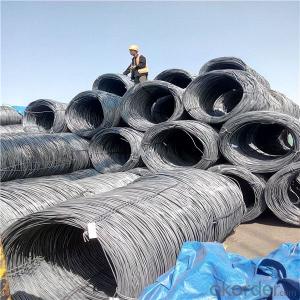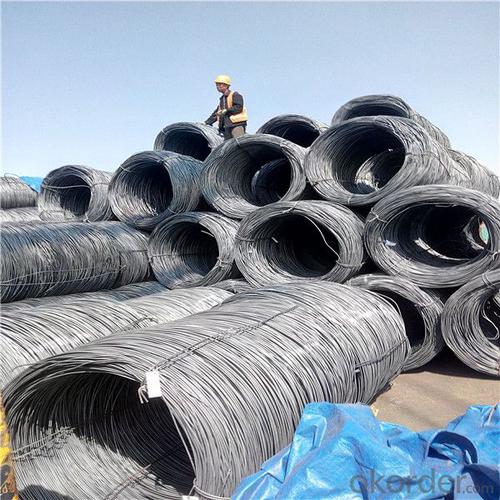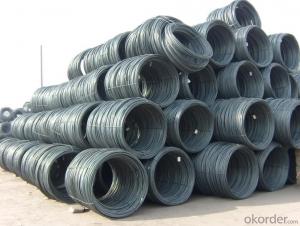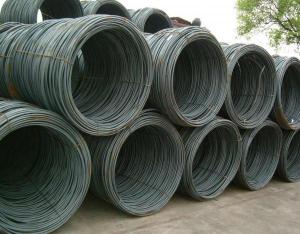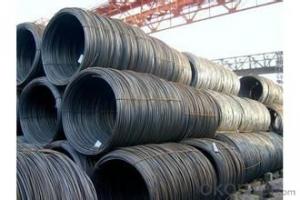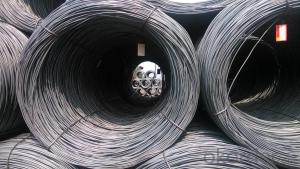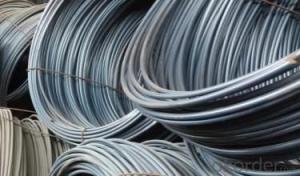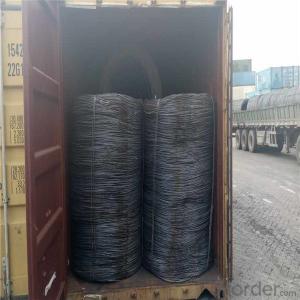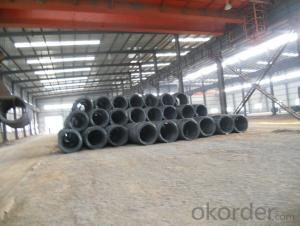Steel Wire Rod Coil Low Carbon different grade
- Loading Port:
- Shanghai
- Payment Terms:
- TT OR LC
- Min Order Qty:
- 50 m.t.
- Supply Capability:
- 18321 m.t./month
OKorder Service Pledge
OKorder Financial Service
You Might Also Like
Specification
Drawing Grade wire rods are used by downstream industries for various applications such as making
wires for welded mesh, nails, hangers, screws, chain link & gabion fencing, wire nets, barbed wires
and binding wires.
Wire rod is used for many different products. Depending upon how it is cold formed and heat treated, wire is
used, for example, to produce not only wire ropes, barbed wire, wire mesh and nails, but also springs, welded
wire mesh and reinforcement wire.
Our service:
(1) We cooperate with famous factories with advanced equipment and well trained workers.
(2) We can provide factory price with trading company service.
(3) We continuously work on the improvement of our processes, guaranteeing
consistently high standards of quality to keep none compensation.
(4) We guarantee 24 hours response and 48 hours solution providing service.
(5) We accept small order quantity before formal cooperation.
(6) We deliver the agreed quality at the agreed time, reacting to changes in
customer wishes in a flexible way.
(7) Due to our volume and selling power, we have excellent freight rates with
shipping lines.
(8) We strive to always be fair and honest in our dealings with customers.
(9) We strive to work together with customers to achieve much more than we can
achieve alone.
(10) Through our passion and commitment we aim to be a market leader in all our
key markets. To maintain our position as market leader we must continue to add
value in all that we do.
Product Description :
Standard | AISI, ASTM, BS, DIN, GB, JIS |
Material/steel grade | Q195-Q235,SAE1006B,SAE1006CR, SAE1008B, SAE1008CR, SAE1010B, SAE1018B, or according to customers requirements |
Wire Gauge | 5.5-12mm |
Coil weight | 1.8-2.1mts |
MOQ | 25MT |
Delivery Time | 15-30 days after receipt of L/C or deposit by T/T |
Packing | In coil and load in container, if large quantity, by bulk vessel; Can be packed as customers' special requirements |
Payment terms | 1).100% irrevocable L/C at sight. 2).30% T/T prepaid and the balance against the copy of B/L. 3).30% T/T prepaid and the balance against L/C |
Application | widely used in machinery parts, manufacturing industry, electronics industry, metal tools and others |
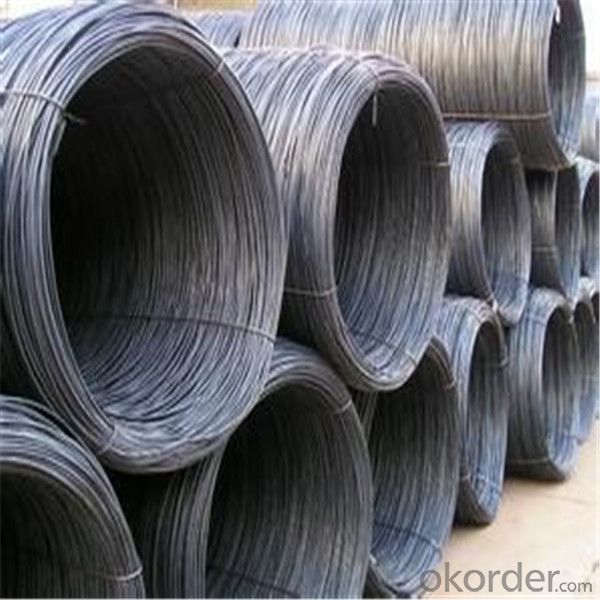
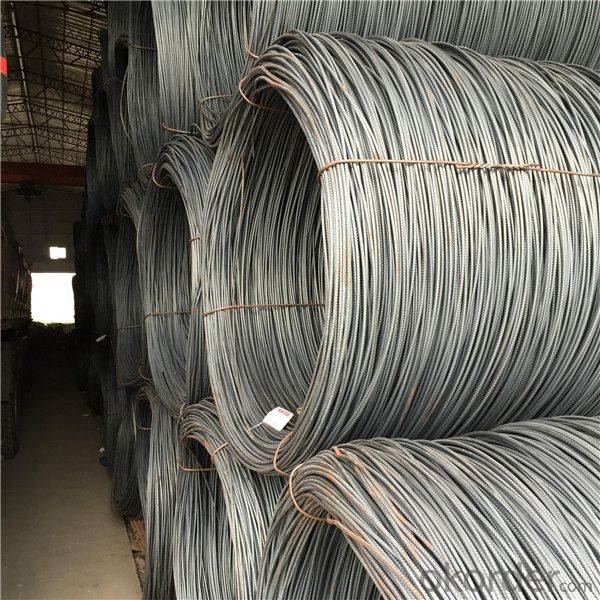
Application :
Mainly used in building and construction as binding wire, tie wire and baling wire; also can be make
for wire mesh.
Packing :
Hot-rolled wire rod is held in a unit with at least four steel straps in the
transverse direction and transported and stored without further packaging.
Before
the steel strapping is applied, the wire rod must be sufficiently compressed.
The strapping is fixed in the transverse direction with a single circumferential
strap so that the strapping does not slip and cause the coil to come apart.
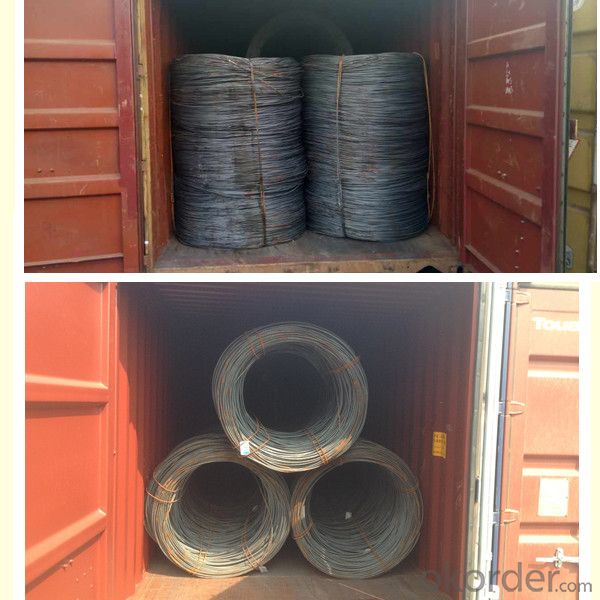
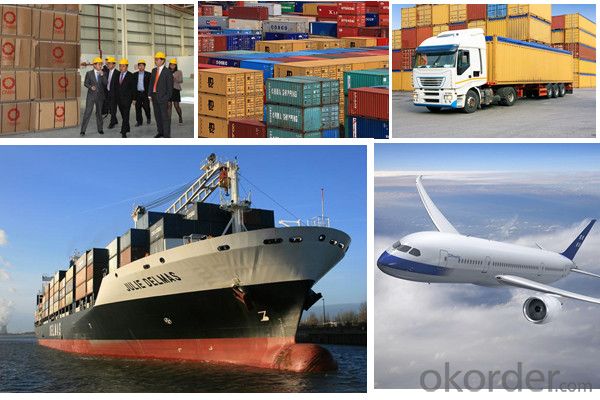
FAQ:
1.Q:Can you accept mixed order?
A: Yes, mixed acceptable .
2. Q: How can I buy CNBM products in my country?
A:Please send us an inquiry or email ,we will reply to you if there is distributor in your country
3. Q: Can we visit your factory?
A: Warmly welcome. Once we have your schedule, we will arrange the
professional sales team to follow up your case.
4. Q: How long does it take to get the product if i place an order?
A:With the process of your requirements,we will pack and deliver in 3
-7 days. If it is by sea shipment,it will take 15-45 days depending on different locations
- Q: How are steel wire rods used in the manufacturing of wire baskets for organizing items?
- Wire baskets used for organizing items rely heavily on steel wire rods as a crucial component. These rods serve as the backbone of the basket, providing the necessary strength and durability. To manufacture wire baskets, steel wire rods undergo a series of manufacturing techniques including drawing, annealing, and galvanizing. Drawing involves reducing the diameter of the rods through a series of dies to achieve the desired thickness for the basket. Annealing, a heat treatment process, enhances the flexibility and malleability of the rods while relieving any stress. Galvanizing is often employed to protect the steel wire rods from corrosion, ensuring their suitability for long-term use. Once prepared, the steel wire rods are shaped into the desired basket form. This involves bending and welding the rods together to create the basket's frame and mesh structure. Specialized machinery is used to bend the rods into the required shape, such as square, rectangular, or circular baskets. During the welding process, the rods are joined together at various points to guarantee the stability and strength of the basket. Depending on the scale of production, this welding process can be carried out manually or through automated machinery. Welding not only reinforces the structure but also improves the durability of the wire basket, enabling it to withstand heavy loads and constant use. After the basic structure is formed, additional features like handles, dividers, or compartments may be incorporated into the wire basket. These features are attached to the steel wire rods through welding or other fastening methods, enhancing organization and convenience for users. Overall, steel wire rods play an indispensable role in the manufacturing of wire baskets for organizing items. Their strength, flexibility, and corrosion resistance make them the ideal choice for creating sturdy and durable baskets capable of efficiently organizing and storing various items.
- Q: How is steel wire rod used in the manufacturing of wire mesh gabions?
- Steel wire rod is a crucial component in the manufacturing of wire mesh gabions as it serves as the primary material for forming the wire mesh. The wire rod is processed through various steps, including drawing, annealing, and galvanizing, to enhance its strength, durability, and corrosion resistance. Once the wire rod is transformed into wire mesh, it is then woven or welded to create the gabion structures. The strength and flexibility of the steel wire rod enable the wire mesh gabions to withstand various forces, making them ideal for erosion control, retaining walls, and other civil engineering applications.
- Q: What are the factors that affect the cost of steel wire rod?
- The cost of steel wire rod can be affected by several factors. Firstly, the price of the raw materials used to produce steel wire rod, such as iron ore and scrap metal, heavily influences its cost. Any fluctuations in these raw material prices can directly impact the cost of steel wire rod. Secondly, the cost of producing steel wire rod includes various expenses like labor, energy, and equipment maintenance. Changes in these production and manufacturing costs can affect the overall cost of the product. Thirdly, the demand for steel wire rod plays a significant role in its cost. If there is high demand and limited supply, the price of steel wire rod may increase. Conversely, if there is low demand and excess supply, the price may decrease. Furthermore, market competition among steel wire rod manufacturers can also impact its cost. Intense competition can lead to lower prices as companies strive to attract customers. Conversely, a lack of competition may result in higher prices. Additionally, the cost of transporting steel wire rod from manufacturers to end-users contributes to its overall cost. Factors such as fuel prices, distance, and transportation infrastructure can affect these costs. Moreover, government regulations and policies, like import duties, export restrictions, or environmental regulations, can impact the cost of steel wire rod. Compliance with these regulations may require additional investments, influencing the product's price. Lastly, exchange rate fluctuations can impact the cost of steel wire rod in different countries. Changes in currency values can affect the import and export prices of steel wire rod, influencing its overall cost. To make informed decisions and strategies regarding the cost of steel wire rod, businesses should monitor and understand these factors.
- Q: How is steel wire rod used in the manufacturing of wire for suspension systems in trains?
- The manufacturing process of wire for suspension systems in trains heavily relies on steel wire rod. The suspension system is responsible for maintaining stability, reducing vibrations, and ensuring a comfortable ride for passengers. Steel wire rod is used to create the wire that forms the foundation of these suspension systems. To achieve the desired strength and flexibility, steel wire rod undergoes a series of techniques such as hot rolling, cold drawing, and heat treatment. This process allows the wire to endure the high forces and constant stress experienced by the suspension system during train operation. Once the steel wire rod is transformed into wire, it undergoes further processing to create the specific suspension components required for train suspension systems. Depending on the design and requirements of the suspension system, the wire is shaped into coil springs, helical springs, or torsion bars. Coil springs are commonly utilized in train suspension systems to absorb shocks and vibrations caused by uneven tracks or sudden changes in speed. These springs are created by tightly coiling the steel wire rod, enabling them to compress and expand as needed, providing the necessary support and cushioning. On the other hand, helical springs are used to support the weight of the train and maintain the proper ride height. They are formed by twisting the steel wire rod into a helix shape, allowing them to bear the load while offering flexibility and damping properties. Torsion bars, another type of suspension component, are employed to resist twisting forces and provide stability. They are manufactured by giving the steel wire rod a solid bar shape, which is then installed horizontally across the train's suspension system. As the train moves, the torsion bars twist, countering the forces that would otherwise cause the train to tilt or sway. In conclusion, steel wire rod is an essential component in the manufacturing process of wire for suspension systems in trains. It undergoes various processing techniques and is shaped into coil springs, helical springs, or torsion bars. These suspension components ensure stability, absorb shocks and vibrations, and guarantee a smooth and comfortable ride for passengers.
- Q: What are the physical properties of a steel wire rod?
- The physical properties of a steel wire rod include its dimensions, strength, hardness, flexibility, and conductivity. Dimensions: Steel wire rods come in various sizes and diameters, typically ranging from 5.5mm to 20mm. The length of the rod can vary depending on the manufacturer and application. Strength: Steel wire rods are known for their high tensile strength, which allows them to withstand heavy loads and tension without breaking or deforming. This strength is a result of the composition of the steel and the manufacturing process. Hardness: Steel wire rods have a certain level of hardness, which refers to their resistance to indentation or scratching. The hardness of the rod can be influenced by the type of steel alloy used and any heat treatment processes applied during manufacturing. Flexibility: Steel wire rods are known for their flexibility and ability to bend without breaking. This flexibility is due to the inherent ductility of the steel material, allowing the rod to be shaped and used in various applications such as construction, automotive, or electrical. Conductivity: Steel wire rods possess excellent electrical conductivity, making them suitable for applications that require the transmission of electrical energy or signals. However, it is important to note that steel is not as conductive as other metals such as copper or aluminum. Overall, steel wire rods are valued for their combination of strength, hardness, flexibility, and conductivity, making them versatile and widely used in different industries and applications.
- Q: What are the common applications of spring steel wire rod?
- Due to their unique properties and characteristics, spring steel wire rods are widely utilized in various industries. They have a multitude of applications, including but not limited to: 1. Springs: The manufacturing of springs heavily relies on spring steel wire rods. These rods provide the necessary elasticity and flexibility required for applications that involve constant or intermittent compression or extension. They are commonly used in automotive suspension systems, mattress springs, door locks, and industrial machinery. 2. Fasteners: Spring steel wire rods are commonly employed in the production of fasteners such as bolts, screws, and rivets. Their high tensile strength and resistance to deformation ensure that these fasteners can withstand significant stress and maintain their structural integrity. 3. Wire forms: The excellent formability of spring steel wire rods makes them suitable for the production of various wire forms, including hooks, clips, rings, and brackets. These wire forms find applications in industries such as construction, automotive, aerospace, and household appliances. 4. Musical instruments: The manufacturing of musical instruments, particularly piano strings and guitar strings, extensively utilizes spring steel wire rods. Their high tensile strength and elasticity result in strings that can produce clear and resonant tones. 5. Fencing and mesh: Spring steel wire rods are commonly employed in the production of fences, mesh screens, and wire grids. Their high strength and durability make them suitable for security fencing, animal enclosures, and industrial sieving applications. 6. Suspension systems: The automotive industry widely uses spring steel wire rods for manufacturing suspension systems. These rods provide the necessary flexibility and resilience to absorb shocks and vibrations, ensuring a smooth and comfortable ride. 7. Electrical conductors: In certain electrical applications, spring steel wire rods are occasionally utilized as conductors. Their high conductivity and ability to withstand high temperatures make them suitable for specific electrical wiring and heating elements. 8. Oil and gas industry: The oil and gas industry employs spring steel wire rods for various purposes, including downhole tools, wireline cables, and coiled tubing. Their high strength and resistance to corrosion make them suitable for demanding environments. In conclusion, spring steel wire rods are versatile and find applications in a wide range of industries due to their unique combination of strength, elasticity, formability, and resistance to deformation.
- Q: How is steel wire rod used in the production of springs for mattresses?
- Steel wire rod is used in the production of springs for mattresses as it serves as the raw material for creating the spring coils. The wire rod is first processed and shaped into a coiled form, which is then further processed to create the desired spring shape and size. This allows for the creation of strong and durable springs that provide support and resilience to mattresses, ensuring a comfortable sleeping surface.
- Q: What are the different production processes for steel wire rod?
- There are several different production processes for steel wire rod, including the basic oxygen furnace (BOF) process, the electric arc furnace (EAF) process, and the continuous casting process. The BOF process involves melting iron ore in a furnace and then blowing oxygen through it to remove impurities and adjust the carbon content. The EAF process uses electricity to melt scrap steel and then refine it through the addition of alloys and fluxes. The continuous casting process involves continuously casting molten steel into a billet or slab shape, which is then rolled into wire rod.
- Q: What are the different types of steel wire rod surface defect detection and analysis tools?
- There are several types of steel wire rod surface defect detection and analysis tools available in the market. Some common tools include visual inspection, ultrasonic testing, magnetic particle testing, eddy current testing, and laser scanning. Each tool has its own advantages and limitations, and the choice of tool depends on factors such as the type of defect, the size of the wire rod, and the required accuracy of detection and analysis.
- Q: How is steel wire rod used in the production of wire for suspension bridge cables?
- The production of wire for suspension bridge cables heavily relies on steel wire rod, a crucial component. This wire rod is made from high-quality steel and is typically manufactured through the process of hot rolling. To create the wire for suspension bridge cables, the steel wire rod goes through various stages of processing. Initially, the wire rod is heated and then passed through a series of rollers, gradually reducing its size and shaping it into a continuous, long wire. This process is commonly referred to as wire drawing. The resulting wire then undergoes further processing to enhance its strength and durability. It is subjected to a heat treatment process, like annealing, which improves its mechanical properties. This treatment increases the wire's tensile strength, ensuring it can endure the immense loads and stresses experienced by suspension bridge cables. Once the wire has been appropriately treated, it is meticulously woven and braided to form the final suspension bridge cable. Multiple wires are twisted together to create strands, and several strands are then twisted together to form a larger cable. This intricate weaving process guarantees that the cable is strong, flexible, and corrosion-resistant. The use of steel wire rod in the production of suspension bridge cables is crucial because of its exceptional strength-to-weight ratio. Steel is renowned for its high tensile strength, making it ideal for supporting heavy loads over long distances. Moreover, steel wire rod offers excellent resistance to corrosion, ensuring the durability and structural integrity of suspension bridge cables. In conclusion, steel wire rod plays a vital role in producing wire for suspension bridge cables, providing the necessary strength, durability, and flexibility required for these critical infrastructure components. Its versatility and reliability make it the preferred material choice in constructing suspension bridge cables, guaranteeing the safety and functionality of these remarkable engineering marvels.
Send your message to us
Steel Wire Rod Coil Low Carbon different grade
- Loading Port:
- Shanghai
- Payment Terms:
- TT OR LC
- Min Order Qty:
- 50 m.t.
- Supply Capability:
- 18321 m.t./month
OKorder Service Pledge
OKorder Financial Service
Similar products
Hot products
Hot Searches
Related keywords
